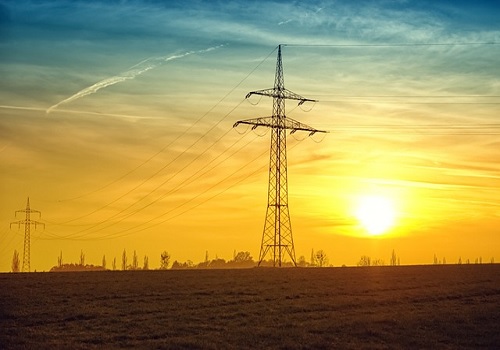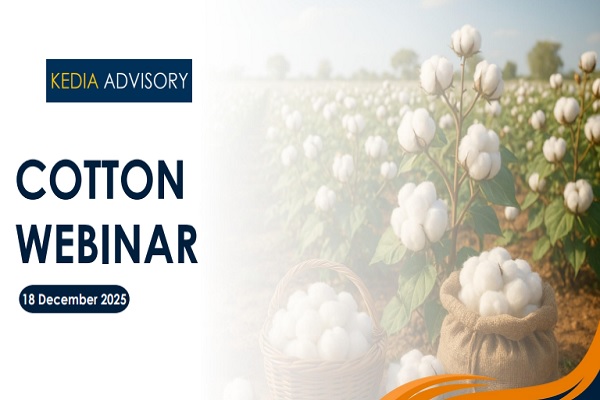Gold trading range for the day is 70740-73100 - Kedia Advisory

Gold
Gold prices fell by 2.01% to settle at 71,577, driven by profit-taking after the U.S. Federal Reserve's latest meeting minutes suggested that interest rates would remain higher for an extended period. This hawkish stance by the Fed has dampened investor enthusiasm for gold, traditionally seen as a hedge against inflation. Additionally, concerns have arisen that elevated gold prices might deter purchases by central banks, who were notably active buyers in 2022-2023, and also impact demand from Chinese investors. In India, the world's second-largest gold consumer, imports are projected to decline by nearly 20% in 2024. This anticipated drop is attributed to high prices prompting consumers to trade old jewelry for new items instead of purchasing additional gold. This shift in consumer behavior could further impact the global gold market. U.S. labor market data showed a mixed picture. The number of people filing for unemployment benefits fell by 8,000 to 215,000 for the week ending May 18th, beating market expectations of 220,000. Although this figure was below the elevated levels seen earlier in the month, it remained above the averages from February to April, indicating a softer labor market momentum. Moreover, continuing jobless claims increased by 8,000 to 1,794,000, the highest level in over a month. Technically, the gold market is experiencing long liquidation, evidenced by an 11.23% drop in open interest to 7,413 contracts while prices fell by 1,469 rupees. Gold currently finds support at 71,160, with a potential test of 70,740 if this level fails to hold. On the upside, resistance is likely at 72,340, and a move above this level could see prices testing 73,100.
Trading Ideas:
* Gold trading range for the day is 70740-73100.
* Gold declined on profit-taking after minutes from the U.S. Federal Reserve's latest meeting.
* Fed’s latest meeting indicated that interest rates would stay higher for longer.
* The market has also been concerned that high gold prices could affect purchases by central banks, which were active buyers in 2022-2023.
silver
Yesterday, silver prices dropped by -2.77%, closing at 90,437, driven by the latest Federal Reserve meeting minutes suggesting the possibility of further interest rate hikes. The minutes highlighted concerns among some officials about the lack of substantial progress toward the Fed's 2% inflation target, despite some easing over the past year. The FOMC's stance of maintaining the current target range for the federal funds rate was based on solid economic growth indicators. Traders' sentiment now reflects growing uncertainty regarding multiple rate cuts by the Fed in 2024, with a 73% probability of a rate cut by November. Additionally, labor market data released last week indicated a drop in new unemployment claims, suggesting underlying strength in the labor market. The Labor Department reported the second consecutive weekly decline in claims, offsetting the previous rise and pointing to a resilient job market despite slowing job growth due to the cumulative impact of the Fed's interest rate hikes in 2022 and 2023. Low layoff levels further support the economy's robustness. From a technical perspective, the silver market is experiencing long liquidation, evidenced by a 6.13% decrease in open interest, settling at 24,970 contracts. Prices fell by 2,576 rupees. Currently, silver has support at 89,510, and a decline below this level could see prices test 88,585. On the upside, resistance is anticipated at 92,100, with potential for prices to reach 93,765 if this level is surpassed. Investors remain cautious, balancing the prospects of continued economic strength against potential further tightening of monetary policy.
Trading Ideas:
* Silver trading range for the day is 88585-93765.
* Silver dropped as Fed’s minutes suggested that some officials were considering raising interest rates.
* Traders' sentiment now indicates increasing uncertainty about the Fed making multiple rate cuts in 2024, with a 73% probability of a rate cut by November.
* The number of Americans filing new claims for unemployment benefits fell last week
Crude oil
Crude oil prices dropped by 1.46% to settle at 6397, driven by concerns over demand and rising US stockpiles. According to the latest EIA report, US crude inventories increased, with Cushing, Oklahoma's storage hub reaching its highest level since July. This rise in stockpiles, coupled with the recent Federal Reserve minutes indicating a potential for further tightening of monetary policy to control inflation, has raised worries about a potential dampening of energy demand in the world's largest oil consumer. Adding to the bearish sentiment, Russia acknowledged exceeding its OPEC+ production quota in April due to "technical reasons" and indicated plans to propose a compensatory scheme. Market participants are now focused on the upcoming OPEC+ meeting on June 1, where major oil producers are expected to discuss extending output cuts to prevent global oversupply and support prices. In the US, weekly imports of crude oil from Mexico fell to a record low of 184,000 barrels per day last week, down from the previous low of 208,000 bpd recorded in the week ending April 12, Furthermore, the EIA's monthly Drilling Productivity Report projected that US oil output from the top shale-producing regions would rise in June to its highest level in six months, reaching 9.85 million bpd, the highest since December. Technically, the crude oil market is experiencing fresh selling pressure, with open interest increasing by 21.59% to 8,543 contracts while prices fell by 95 rupees. Crude oil is currently finding support at 6338, with a potential further test of 6279 levels if support fails. On the upside, resistance is expected at 6506, and a move above this level could see prices testing 6615.
Trading Ideas:
* Crudeoil trading range for the day is 6279-6615.
* Crude oil dropped amid concerns over demand and increasing US stockpiles.
* US crude inventories rose, with Cushing, Oklahoma's storage hub reaching its highest level since July, the EIA report showed.
* Russia said that it exceeded its OPEC+ production quota in April for “technical reasons” and will propose a plan to compensate for the error.
Naturalgas
Yesterday, natural gas prices fell sharply by -4.57%, closing at 223.5. This decline was driven by an increase in daily output and a storage build reported by the U.S. Energy Information Administration (EIA). U.S. utilities added 78 billion cubic feet (bcf) of gas into storage last week, slightly below market expectations of an 84 bcf increase. Nevertheless, the gas stockpiles are 28.8% above the five-year average, indicating ample supply. Additionally, gas production has seen a notable increase. Output has risen by 0.9 billion cubic feet per day (bcfd) since reaching a 15-week low on May 1, as some drillers responded to higher prices by boosting production. Despite this recent increase, gas output in the Lower 48 U.S. states has averaged 97.4 bcfd so far in May, down from 98.2 bcfd in April, and still below the monthly record of 105.5 bcfd set in December 2023. The return of the Freeport LNG plant in Texas has also contributed to rising gas flows to major U.S. LNG export plants in May. However, overall U.S. gas production remains down by about 8% in 2024 due to several energy firms, including EQT and Chesapeake Energy, delaying well completions and reducing drilling activities following price drops to 3-1/2-year lows in February and March. From a technical perspective, the natural gas market is experiencing long liquidation, as evidenced by a substantial 44.74% decrease in open interest, settling at 9,365 contracts. Prices fell by 10.7 rupees. Currently, natural gas has support at 214.6, and a decline below this level could see prices test 205.7. On the upside, resistance is anticipated at 238, with potential for prices to reach 252.5 if this level is surpassed.
Trading Ideas:
* Naturalgas trading range for the day is 205.7-252.5.
* Natural gas dropped due to increased daily output and a storage build.
* US utilities added 78 billion cubic feet (bcf) of gas into storage last week, compared with market expectations of an 84 bcf increase.
* Output has increased by 0.9 bcfd since hitting a 15-week low on May 1, indicating that some drillers started producing more gas.
Copper
Copper prices fell by 0.66% to settle at 890.2, driven by profit-taking and resistance from consumers to buy at near-record levels. In China, copper inventory has reached a four-year high as demand has waned following prices surpassing $10,000 a ton. A research note from BNP Paribas highlighted an estimate of 500,000 tons of unsold wire-rod copper stock in China, indicating significant oversupply. The global refined copper market exhibited a surplus of 125,000 metric tons in March, compared to a surplus of 191,000 metric tons in February, according to the International Copper Study Group (ICSG). World refined copper output in March was 2.33 million metric tons, while consumption was 2.20 million metric tons. Adjusted for changes in inventory in Chinese bonded warehouses, the surplus in March stood at 138,000 metric tons, down from 221,000 metric tons in February. Southern Copper, Peru's third-largest copper producer controlled by Grupo Mexico, has ambitious plans to increase its copper production by 520,000 metric tons in the next 8-10 years through an $8.5 billion project portfolio. Meanwhile, China's refined copper production in April rose 9.2% year-on-year to 1.14 million metric tons, according to the National Bureau of Statistics. On a daily basis, average copper output in April was 38,000 tons, slightly higher than the 37,000 tons average in March. Technically, the copper market is undergoing long liquidation, as evidenced by a 37.79% drop in open interest to 1,760 contracts while prices decreased by 5.95 rupees. Copper is currently finding support at 879.4, with a potential test of 868.6 if this level fails. On the upside, resistance is expected at 901.6, and a move above this level could see prices testing 913.
Trading Ideas:
* Copper trading range for the day is 868.6-913.
* Copper prices fell as profit-taking continued
* Copper market in 125,000 metric tons surplus in Mar 2024 – ICSG
* Copper inventory remained at a four-year high in China, as demand waned after prices surpassed $10,000 a ton.
Zinc
Zinc prices closed marginally higher by 0.04% at 271.85, with subdued near-term demand counterbalanced by speculative activity that fueled a widespread rally in base metals throughout the month. Despite the modest uptick, market sentiment remains cautious due to tepid demand dynamics in the immediate future. Data from the International Lead and Zinc Study Group (ILZSG) revealed a decrease in the global zinc market surplus to 52,300 metric tons in March, down from 66,800 tons in February. However, the surplus for the first three months of the year stood at 144,000 tons, compared to 201,000 tons during the same period last year, indicating ongoing supply dynamics. In China, refined zinc output in April recorded a month-on-month decline of 3.99% and a year-on-year decrease of 6.56%, totaling 504,600 metric tons. While the cumulative output from January to April decreased slightly by 0.47% year-on-year, it aligned with market expectations. Domestic zinc alloy production saw a modest increase in April, reaching 95,500 metric tons. However, domestic smelter output faced challenges due to routine maintenance and equipment issues in various provinces, leading to a notable decrease in overall output. Retail sales in China rose by 2.3% year-on-year in April, below market forecasts and moderating from the previous period, signaling a softening trend in consumer demand. From a technical standpoint, the zinc market saw short covering as open interest dropped significantly by 29.72% to settle at 1,315 contracts, while prices saw a minor increase of 0.1 rupees. Currently, zinc finds support at 268.3, with a potential decline to 264.6 below this level. Resistance is anticipated at 274.9, with a possible test of 277.8 if breached.
Trading Ideas:
* Zinc trading range for the day is 264.6-277.8.
* Zinc settled flat amid poor demand in the near term weighed
* Global zinc market surplus falls in March, ILZSG says
* China's refined zinc output was 504,600 mt, a month-on-month decrease of 20,900 mt or 3.99%.
Aluminium
Aluminium prices experienced a decline of 0.68% to settle at 239.85, influenced by China's substantial surge in imports of unwrought aluminium and products. April imports saw a staggering 72.1% year-on-year increase to 380,000 metric tons, with the first four months of the year totaling 1.49 million tons, up 86.6% from the same period in the previous year. The notable rise in imports is attributed to increased flows from Russia, which saw imports totaling 392,775 tons in the first quarter, up 127.7% from the previous year. With recent sanctions on Russian metals by the US and Britain due to Russia's actions in Ukraine, the influx of Russian aluminium into China is expected to continue, contributing to higher metal stocks in the country. Moreover, global primary aluminium output in April rose by 3.3% year-on-year to 5.898 million tonnes, as per data from the International Aluminium Institute. China, the world's largest aluminium producer, witnessed a 7.2% increase in primary aluminium production in April compared to the previous year, producing 3.58 million metric tons. This uptick was driven by rising aluminium prices both domestically and globally. Technically, the aluminium market is undergoing long liquidation, with open interest dropping by 17.82% to 1,236 contracts while prices declined by 1.65 rupees. Currently, aluminium finds support at 237.4, with a potential test of 234.8 levels if this support is breached. On the upside, resistance is expected at 242, and a move above this level could lead to testing 244.
Trading Ideas:
* Aluminium trading range for the day is 234.8-244.
* Aluminium prices dropped as China's April aluminium imports jump 72.1% YOY
* Aluminium stocks on the SHFE stood at 231,765 tons, up 139.8% from the beginning of this year and near a one-year peak.
* Global aluminium output rises 3.3% year on year in April – IAI
Cotton candy
Cotton candy prices surged by 0.93% to settle at 56,500, driven by robust demand for Indian cotton from key buyers like Bangladesh and Vietnam. However, the upside was limited due to sluggish milling demand amid muted global yarn demand. Prospects of a better crop in countries like Australia also tempered the upward momentum. The International Cotton Advisory Committee (ICAC) projected increases in cotton-producing areas, production, consumption, and trade for the upcoming season, 2024-25. Meanwhile, in India, cotton stocks are anticipated to plummet by nearly 31% in 2023/24, reaching their lowest level in over three decades due to lower production and rising consumption. This could restrain exports from the world's second-biggest producer, supporting global prices but potentially pressuring the margins of local textile companies. For marketing year 2024/25, India's cotton production is estimated at 25.4 million 480 lb. bales, with mill consumption expected to rise to 24.5 million bales as yarn and textile demand improves internationally. Import duties on extra-long staple (ELS) cotton have been rescinded, leading to an estimated 20% increase in imports. In contrast, China's cotton imports for MY 2024/25 are forecasted at 2.4 million metric tons, driven by higher domestic and international demand for textile and apparel products. China's cotton production for the same period is expected to be stable in Xinjiang but declining in other regions. Technically, the cotton candy market saw short covering, with a significant drop in open interest by 21.89% and prices rising by 520 rupees. Support for Cottoncandy is identified at 56,040, with a potential test of 55,570 if this level is breached. On the upside, resistance is anticipated at 56,840, with a move above potentially leading to testing 57,170.
Trading Ideas:
* Cottoncandy trading range for the day is 55570-57170.
* Cotton gains as demand for India cotton continues to be strong from buyers
* U.S. ending stocks projected 1.3 million bales above 2023/24 level
* Global supplies in 2024/25 projected to be higher than previous year
* In Rajkot, a major spot market, the price ended at 27255.75 Rupees dropped by -0.21 percent.
Turmeric
Turmeric prices experienced a decline of -1.27% yesterday, settling at 19,398, driven by profit booking and increased supplies at the end of the harvesting season. However, the downside was limited as farmers are holding back stocks in anticipation of further price rises. Additionally, the prevailing heatwave across India poses a significant threat to crop yields, exacerbating the supply crunch and providing support to prices. The India Meteorological Department forecasts continued hot weather across most parts of India, with rainfall in southern regions significantly below normal levels in April. Despite expectations of reduced production in 2023-24 compared to the previous year, turmeric exports during April-March 2024 decreased by 4.75%, while imports dropped by 12.71% during the same period. However, there was a notable month-on-month increase in both exports and imports in March 2024, indicating some volatility in trade patterns. In terms of domestic demand, turmeric-growing regions such as Sangli, Basmat, and Hingoli are witnessing strong demand for quality produce, driven by expectations of an increase in sowing area in the current year. In the major spot market of Nizamabad, prices ended slightly higher, reflecting ongoing market dynamics. Technically, the turmeric market is undergoing long liquidation, with a drop in open interest by -2.47% to settle at 16,025 contracts, alongside a decrease in prices by -250 rupees. Currently, turmeric finds support at 19,164, with a potential decline to 18,928 below this level. Resistance is anticipated at 19,818, with a possible test of 20,236 if surpassed.
Trading Ideas:
* Turmeric trading range for the day is 18928-20236.
* Turmeric dropped amid profit booking and as increase in supplies at the end of harvesting season.
* The current heat wave could severely damage the crop yield, further contributing to the supply crunch.
* The Ministry of Agriculture first advance estimate for turmeric production in 2023-24 is estimated at 10.74 lakh tonnes
* In Nizamabad, a major spot market, the price ended at 18028.8 Rupees gained by 0.3 percent.
Jeera
Jeera prices edged up by 0.31% to settle at 29,330 amid a slowdown in arrival pace, as stockists and farmers held back their stocks in anticipation of better price realization. The arrival of jeera at major APMC mandis across India increased slightly in the first week of May, signaling ongoing market activity. Export demand is expected to rise, supported by robust demand and aggressive buying by stockists, with Indian jeera being preferred by global buyers due to tightening global supplies. Favorable weather conditions and increased sowing areas in key cumin-producing regions of Gujarat and Rajasthan have led to a significant increase in production, with estimates suggesting a two-fold increase compared to the previous year. This surge in production is likely to impact export volumes positively, with trade analysts anticipating a substantial increase in cumin exports in February 2024. However, despite the positive outlook for exports, jeera exports during April-March 2024 dropped by 13.53% compared to the previous year, reaching 152,189.32 tonnes. Nevertheless, there was a notable increase in exports in March 2024 compared to February 2024 and March 2023, indicating some recovery in export volumes. In Unjha, a major spot market, jeera prices ended at 30,739.85 rupees, dropping by 0.69% indicating some volatility in spot market prices. Technically, the jeera market is experiencing fresh buying, with open interest increasing by 3.45% to settle at 3,150 contracts while prices rose by 90 rupees. Jeera is currently finding support at 28,960, with potential further testing of 28,590 if this level is breached. On the upside, resistance is likely at 29,750, with a move above potentially leading to testing 30,170. verall, the jeera market shows signs of stability and resilience amid fluctuating export volumes and increasing domestic production.
Trading Ideas:
* Jeera trading range for the day is 28590-30170.
* Jeera prices gained as arrival pace has started slowed down.
* Global buyers preferred Indian jeera with tightening global supplies.
* New arrivals have started in Gujarat since last 20-25 days and new arrivals have started in Rajasthan also since last 15 days.
* In Unjha, a major spot market, the price ended at 30739.85 Rupees dropped by -0.69 percent.
Views express by all participants are for information & academic purpose only. Kindly read disclaimer before referring below views.























